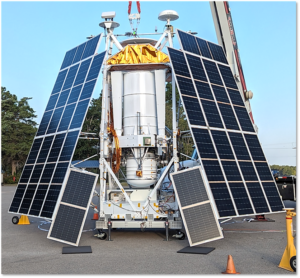NASA’s GUSTO balloon observatory has arrived on Antarctica onboard the Wallops C-130 airplane. It is scheduled for launch around the 15th of December. GUSTO is equipped with three 8-pixel far-infrared cameras delivered by SRON and TU Delft and will carry out the first large-scale survey with velocity-resolved imaging of the spectral lines emitted by three cosmic elements between stars.
NASA’s Galactic/Extragalactic ULDB Spectroscopic Terahertz Observatory (GUSTO) is a balloon observatory that will drift and circulate in the Earth’s atmosphere at 36 km altitude above Antarctica for 55 days. The observatory is carried by an Ultra-Long Duration helium balloon with the size of a football field and consists of a telescope one meter in diameter and a cryogenic instrument with superconducting detectors operating at -269 °C. GUSTO carries three array receivers for far-infrared radiation of 1.4, 1.9, and 4.7 terahertz to detect and map emission lines of respectively ionized nitrogen [NI], carbon [CII], and oxygen [OI] in the interstellar medium (ISM)—the gas and dust in between stars.
Before arriving on Antarctica, GUSTO has gone through a long journey. The detector arrays were first air shipped from Groningen (SRON) to Tucson (University of Arizona). The telescope with the cryogenic instrument was transported from Tucson to Maryland (Johns Hopkins Applied Physics Laboratory) by a truck. GUSTO’s payload integrated with a gondola was then further moved to Texas (CSBF), again by a truck. Due to a distance of 16100 kilometers from Texas to McMurdo located at Ross Island, Antarctica, the C130 airplane has made a few stops on its way to GUSTO’s final destination.
GUSTO will lift off from Williams Field, Antarctica, on the 15th of December as the baseline launch date. However, the exact date will depend on when the stratospheric, circumpolar vortex above Antarctica is formed and on the weather conditions at the launch site. The vortex allows GUSTO to float circularly at an altitude of 36 km. Normally speaking it will last longer than 55 days. However, once the vortex breaks down, GUSTO will spiral outwards, and the observation efficiency will decrease slowly because of an increased temperature difference between day and night and a reduced electrical power from the solar panels. Eventually, GUSTO will be terminated and likely drop into the ocean or in Australia. It is not going to be salvaged by NASA because GUSTO is the first balloon observatory in history to be managed as a space mission.
GUSTO is led by the University of Arizona. SRON and TU Delft (Department of Imaging Physics, Faculty of Applied Physics) delivered the so-called Hot Electron Bolometer multi-pixel (heterodyne) cameras and a novel phase grating for creating a multi-beam local oscillator originated from a single 4.7 THz quantum cascade laser. The local oscillator helps the detectors to determine the exact color of the incoming far-infrared light. Furthermore, Jose Silva on behalf of the Dutch GUSTO team will fly down to McMurdo, and contribute the GUSTO’s Antarctica flight campaign.
Contact
Jian-Rong Gao
J.R.Gao@tudelft.nl

